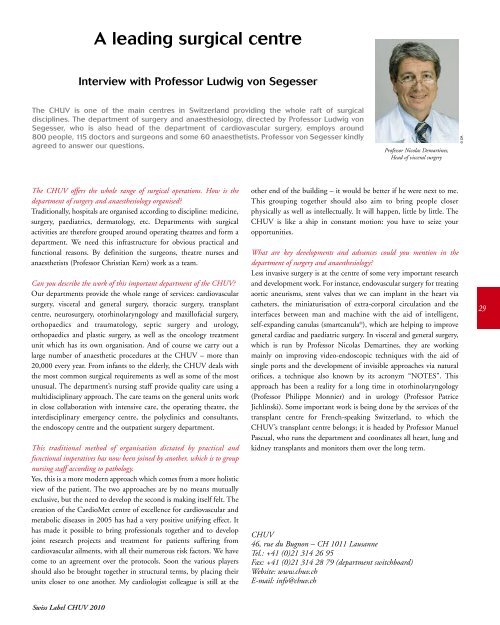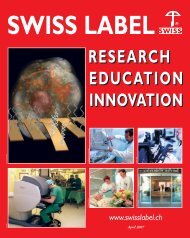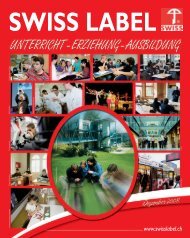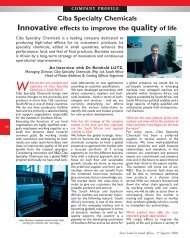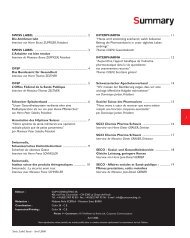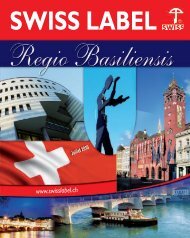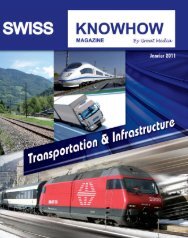SWISS LABEL INFORMATIQUE-XP - Com Consulting SA
SWISS LABEL INFORMATIQUE-XP - Com Consulting SA
SWISS LABEL INFORMATIQUE-XP - Com Consulting SA
You also want an ePaper? Increase the reach of your titles
YUMPU automatically turns print PDFs into web optimized ePapers that Google loves.
A leading surgical centreInterview with Professor Ludwig von SegesserThe CHUV is one of the main centres in Switzerland providing the whole raft of surgicaldisciplines. The department of surgery and anaesthesiology, directed by Professor Ludwig vonSegesser, who is also head of the department of cardiovascular surgery, employs around800 people, 115 doctors and surgeons and some 60 anaesthetists. Professor von Segesser kindlyagreed to answer our questions.Professor Nicolas Demartines,Head of visceral surgery© DRThe CHUV offers the whole range of surgical operations. How is thedepartment of surgery and anaesthesiology organised?Traditionally, hospitals are organised according to discipline: medicine,surgery, paediatrics, dermatology, etc. Departments with surgicalactivities are therefore grouped around operating theatres and form adepartment. We need this infrastructure for obvious practical andfunctional reasons. By definition the surgeons, theatre nurses andanaesthetists (Professor Christian Kern) work as a team.Can you describe the work of this important department of the CHUV?Our departments provide the whole range of services: cardiovascularsurgery, visceral and general surgery, thoracic surgery, transplantcentre, neurosurgery, otorhinolaryngology and maxillofacial surgery,orthopaedics and traumatology, septic surgery and urology,orthopaedics and plastic surgery, as well as the oncology treatmentunit which has its own organisation. And of course we carry out alarge number of anaesthetic procedures at the CHUV – more than20,000 every year. From infants to the elderly, the CHUV deals withthe most common surgical requirements as well as some of the mostunusual. The department’s nursing staff provide quality care using amultidisciplinary approach. The care teams on the general units workin close collaboration with intensive care, the operating theatre, theinterdisciplinary emergency centre, the polyclinics and consultants,the endoscopy centre and the outpatient surgery department.This traditional method of organisation dictated by practical andfunctional imperatives has now been joined by another, which is to groupnursing staff according to pathology.Yes, this is a more modern approach which comes from a more holisticview of the patient. The two approaches are by no means mutuallyexclusive, but the need to develop the second is making itself felt. Thecreation of the CardioMet centre of excellence for cardiovascular andmetabolic diseases in 2005 has had a very positive unifying effect. Ithas made it possible to bring professionals together and to developjoint research projects and treatment for patients suffering fromcardiovascular ailments, with all their numerous risk factors. We havecome to an agreement over the protocols. Soon the various playersshould also be brought together in structural terms, by placing theirunits closer to one another. My cardiologist colleague is still at theother end of the building – it would be better if he were next to me.This grouping together should also aim to bring people closerphysically as well as intellectually. It will happen, little by little. TheCHUV is like a ship in constant motion: you have to seize youropportunities.What are key developments and advances could you mention in thedepartment of surgery and anaesthesiology?Less invasive surgery is at the centre of some very important researchand development work. For instance, endovascular surgery for treatingaortic aneurisms, stent valves that we can implant in the heart viacatheters, the miniaturisation of extra-corporal circulation and theinterfaces between man and machine with the aid of intelligent,self-expanding canulas (smartcanula ® ), which are helping to improvegeneral cardiac and paediatric surgery. In visceral and general surgery,which is run by Professor Nicolas Demartines, they are workingmainly on improving video-endoscopic techniques with the aid ofsingle ports and the development of invisible approaches via naturalorifices, a technique also known by its acronym “NOTES”. Thisapproach has been a reality for a long time in otorhinolaryngology(Professor Philippe Monnier) and in urology (Professor PatriceJichlinski). Some important work is being done by the services of thetransplant centre for French-speaking Switzerland, to which theCHUV’s transplant centre belongs; it is headed by Professor ManuelPascual, who runs the department and coordinates all heart, lung andkidney transplants and monitors them over the long term.CHUV46, rue du Bugnon – CH 1011 LausanneTel.: +41 (0)21 314 26 95Fax: +41 (0)21 314 28 79 (department switchboard)Website: www.chuv.chE-mail: info@chuv.ch29Swiss Label CHUV 2010


